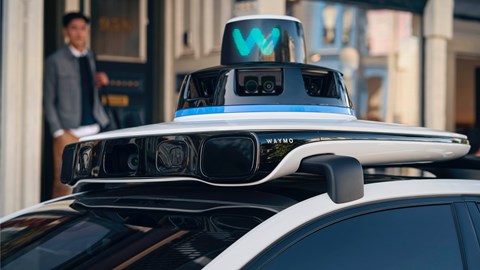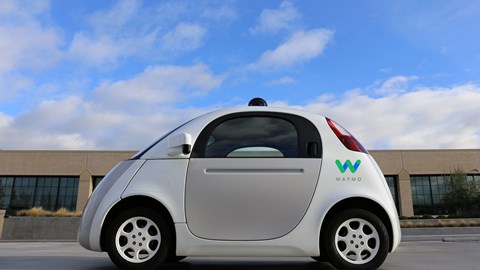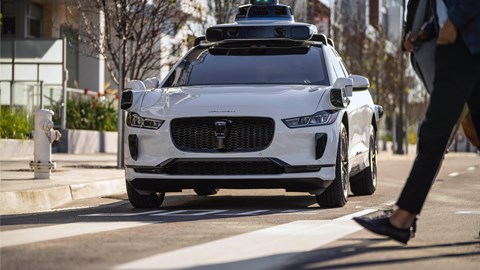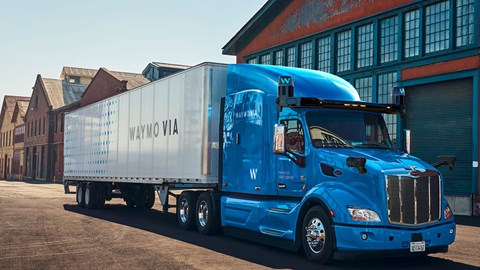► Google’s robot cars with no drivers
► How Waymo Driver senses the world
► When Waymo One will be in the UK
The idea of autonomous vehicles is something many keen drivers sneer at. The concept of taking control away from a human driver doesn’t send taxi drivers wild with excitement either. But happy or not, self-driving cars are real. Drivers are increasingly familiar with pre-cursor level 1-3 driver assist technologies. Yet, few autonomous vehicles are as well-known as Google’s self-driving car project, which eventually matured into five-year-old start-up, Waymo.
While a tech company making an automotive product sounds like something out of the Elon Musk playbook, when you consider that self-driving intelligence is founded on mapping physical environments, geographies and data collation, it’s a lot less pie in the sky for a company like Google to build a self-driving car than such a venture initially sounds.

‘A new way forward in mobility’ is the phrase from which the brand coined its name in 2015 when established. However, the seed for the Google self-driving car actually began with StreetView.
How did Google StreetView influence Google’s self-driving car?
It all began with the US military actually. The Defense Advanced Research Projects Agency (DARPA) challenged the world to enter functioning self-driving cars into a desert-based competition in 2004.
By bringing together like-minded robotics enthusiasts, all of whom brought a different aspect of the science to the table, a community willing to share intel was formed. By the 2007 DARPA Urban Challenge, entrants from Stanford and Carnegie Mellon, a university known for its robotics research, and other passionate robotisists were now competing and collaborating but this time in a city environment.
These challenges proved a pivotal moment for the realisation of autonomous technologies to automotive consciousness. They introduced lidar (laser imaging, detection and ranging) and machine-learning-based artificial intelligence, both of which have proved to be a step-change in mapping environments.
How did Google get involved?
Computer scientists Sebastian Thrun and Anthony Levandowski met during the DARPA challenges and worked together on a digital mapping software that Google utilised on 100 Toyota Prius (Priuii/Priuses), acquiring the whole team and the access to the software.
As a Google employee, Levandowski was involved in making a robot Prius that delivered pizza autonomously for a Discovery Channel TV programme. He’d invited Google to be part of his pet project but the company declined.
However, the programme aired and the Prius, known as Pribot, demonstrated that driverless cars were a possibility. Project Chaffeur started in early 2009 with Google-financed backing.

With the ambition to ‘to improve road safety and make transportation easier’, the development of Project Chauffeur stayed under the radar until 2010, when the New York Times reported on Google’s driverless pilot ‘hiding in plain view’. In 2015, the iconic ‘Firefly’, custom-built prototypes – featuring no steering wheel or pedals – demonstrated how taxis of the future could move people with mobility impairments, such as blindness.
Eventually the project morphed to become its own brand, Waymo, in 2016 under Google’s parent company, Alphabet.
What cars and technology does Waymo use?
Using a variety of cars, including Lexus SUVs and Chrysler Pacifica Hybrid MPVs, Waymo’s autonomous vehicle technology involves lidar, cameras and other sensors to read, map and analyse their environments.
The MPVs are the first vehicles to be built on a purpose-designed platform and Waymo is currently testing their technology on Jaguar’s I-Pace platform.

The cars are called Waymo One and the Waymo Driver is the name given to the suite of sensors that operate the vehicles’ fully autonomous driving technology. Combining lidar with cameras and radar imaging, the Waymo Driver perceives its environment.
It then uses machine-learning, a type of artificial intelligence, to build on its knowledge – ‘judging’ its route, understanding the intention of other drivers and road users and accurately predicting their behaviour to make good driving decisions.
Do Waymo cars have a human safety driver?
Not anymore. Waymo is confident enough that enough miles have been built into its programme, which is disseminated to all vehicles via the cloud, so beta-test Waymo Ones turn up without a driver to take riders to their destination.
Of course, it doesn’t always go smoothly. This rider uploaded an unedited video of a journey going awry. The Waymo Driver contacts a call centre, where a customer service representative can monitor the situation and help the Driver make a decision. The rep can’t, however, drive the car remotely. That isn’t an option.
What happens when a Waymo self-driving car breaks down?
Waymo deploys a roadside assistance truck to attend when a self-driving car breaks down. The call centre rep stays in contact with the rider to reassure them, but as you can see in the video, a number of things don’t align. For example, the rider’s app shows the estimated time of arrival (ETA) to be 12 minutes when the screen inside the vehicle stays one minute.
Then when a cone is removed and the car gets going again, driving away from the recovery truck, only to get stuck at another set of cones. Eventually, the car is disengaged, the recovery driver steps into the car, and moves the vehicle into manual mode to complete the rider’s journey.
It’s interesting though, that unlike some black cab drivers, when the Waymo Drivers turn back into real humans, they’re not especially chatty!
While it’s relatively entertaining to watch this experience of the Waymo One getting confused, it does demonstrate that fully autonomous driverless vehicles are not quite ready for mass deployment.
As the car continues to disengage and re-engage with the traffic (at times, blocking it), an average rider, or even mobility or visually impaired rider, would not necessarily have the same confidence as this understanding beta tester. Waymo has since stated that the issues presented in this video have now been resolved.
What is Waymo Via?
Commercial vehicles are getting the autonomous treatment too. Waymo Via is the autonomous software Waymo is using to get articulated lorries driverless. Using Daimler’s Freightliner Cascadia, testing is taking place in four states in America.

Why is Waymo allowed to test driverless cars on public roads?
It’s a great question. After all, the law states, in the UK at least, that the driver must be in control of the vehicle at all times. It’s for this reason that BMW drivers have to keep their finger down on the fob, when remote parking.
In the US, where the pilot testing is currently taking place, Waymo – as with other companies such as Uber also researching self-driving cars – has been granted special permissions. Regulation has been one of the obstacles holding the development of self-driving cars up. While many hours of simulated driving is one avenue from which the programme learns, nothing beats being out in a live environment and learning by application.
Since cars are…y’know…lethal weapons potentially, regulators have been cautious in what they will allow. Permits are issued provided companies meet strict criteria and vary by state and country.
Will Waymo Ones come to the UK?
Maybe. Waymo wants them to, but UK regulation is holding it back. The Telegraph reported in July 2021 that the government intends to cap the number of driverless cars on UK roads, which Waymo feels would inhibit deployment.
In 2022, the Highway Code and UK law was changed to enable vehicles on an approved list to drive autonomously under 37mph in the UK. No vehicles are yet on the approved list, but since we’re being told we’ll be able to watch telly when they do, CAR will update you when they are. Watch this space.